Growing your business requires a well-planned and effective strategy. The Ansoff Matrix, often known as the Growth Matrix Ansoff, offers an intuitive method for organizations to understand their strategic planning. This article will provide an in-depth understanding of the Ansoff Matrix, illustrating its importance, understanding product development, and explaining how Boardmix can aid in visualizing and planning using this tool. Let's delve deeper into it!
What is the Ansoff Matrix
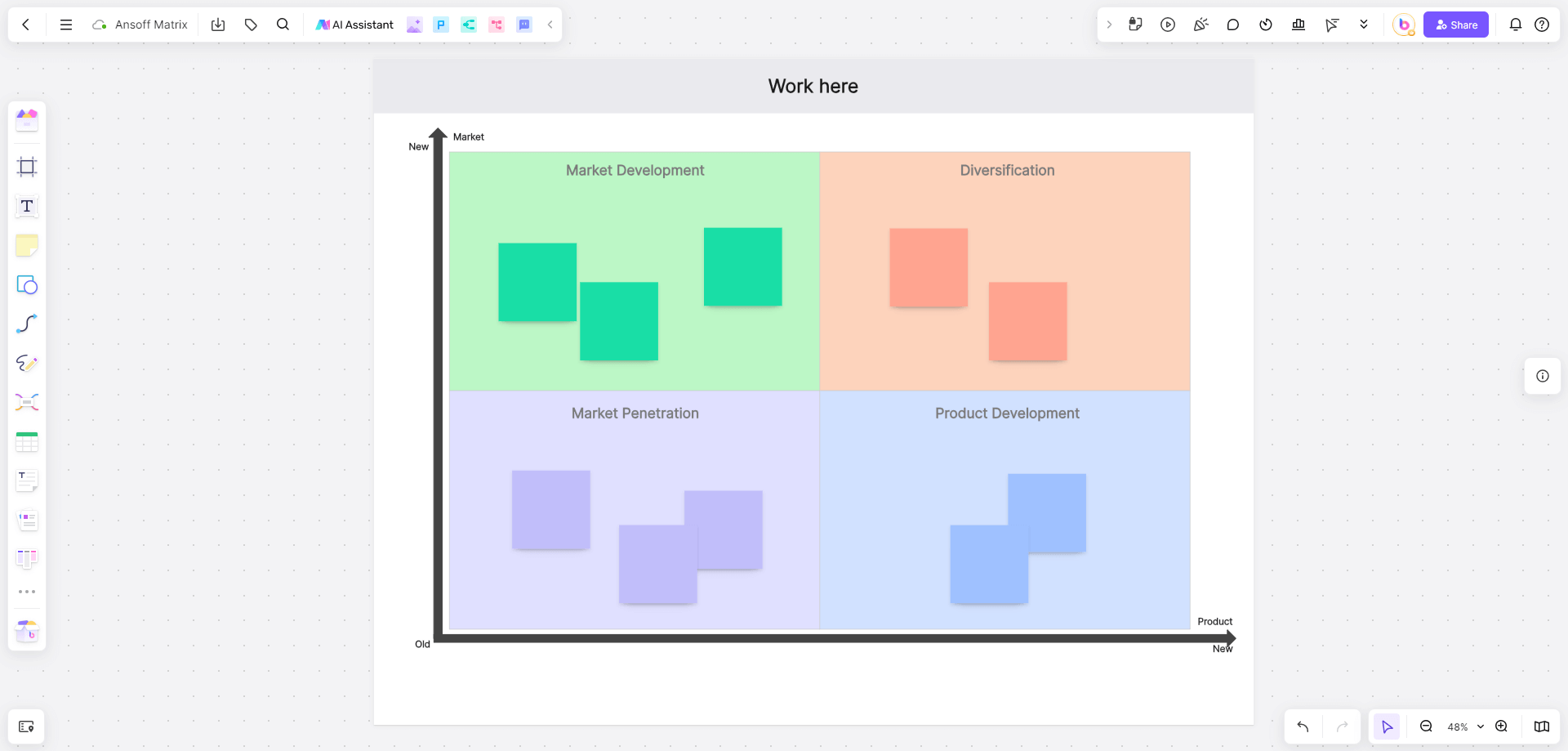
The Ansoff Matrix was introduced in 1957 by H. Igor Ansoff as a strategic planning tool that provides a framework to devise growth strategies by considering the relationship between a firm’s existing and potential products and markets.
The matrix consists of four strategies: market penetration, product development, market development, and diversification. These strategies help organizations plan and identify growth opportunities in their current markets or new ones.
Understanding this matrix is crucial for any business looking for strategic growth, as it allows them to plan for expansion and manage risk effectively. But how can we fully exploit this matrix? The answer lies in understanding the relationship between the company's products and the markets they aim to capture, which is where the growth matrix Ansoff comes into play.
Why is it Important to Use the Growth Matrix Ansoff in Strategic Planning
Strategic planning is crucial for any business looking to grow. It offers direction and assists in setting achievable objectives. In this process, the growth matrix Ansoff plays a pivotal role.
The matrix presents various growth strategies that businesses can use to determine the risk associated with each strategy and identify which is most suitable. It helps companies consider their current market and product situation and devise strategies accordingly.
Whether you want to penetrate an existing market with your current products (market penetration), introduce new products to your existing market (product development), explore new markets with your existing products (market development), or introduce new products into new markets (diversification), the Ansoff Matrix can guide you in making those strategic decisions.
Understanding Product Development in the Context of the Growth Matrix Ansoff
One of the four strategies presented in the growth matrix Ansoff is product development. This strategy involves creating new products or modifying existing ones to sell to the existing market.
Product development is often perceived as risky, but when executed correctly, it could result in increased market share and profitability. The aim is to leverage your brand's standing and customer loyalty to get your customers to buy your new products.
Companies may decide to go for product development when they identify that there are unmet needs within their current market, or when they find that their current products have reached the maturity stage in the product life cycle and need to be replaced or updated. When employing this strategy, an understanding of customer needs, a strong research and development process, and effective market understanding are vital.
How Boardmix Can Assist in Visualizing and Planning Using the Ansoff Matrix
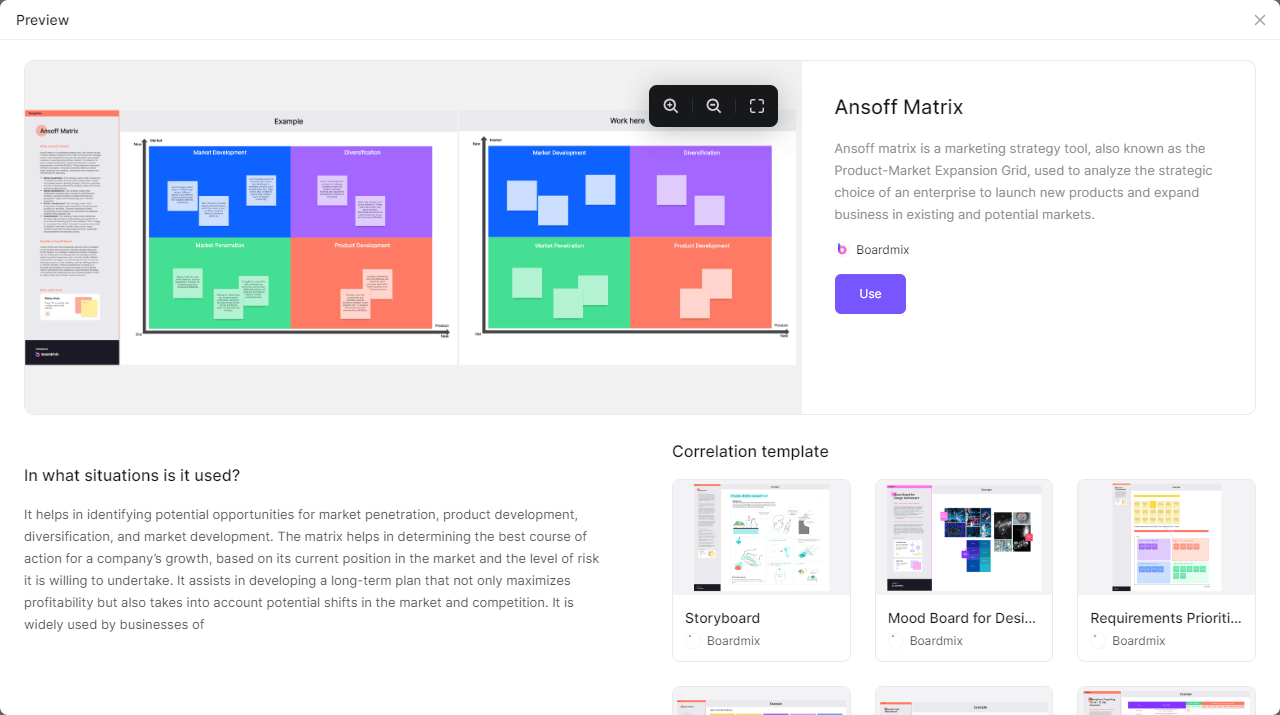
For effective implementation of the Ansoff Matrix, visualization plays an essential role. Boardmix is an innovative software that facilitates such visualization and provides an interactive platform for strategic planning.
Boardmix aids in aligning the strategic plans by allowing team members to visualize the Ansoff Matrix and the four growth strategies. This not only ensures that everyone on the team understands the strategic direction but also allows for collaborative planning.
Furthermore, Boardmix enhances collaboration by enabling teams to work together in real-time. It allows them to identify and map out the different strategies, input ideas, make notes, and provide feedback.
Features of Boardmix That Enhance Collaboration and Strategic Planning
When it comes to strategic planning using the Ansoff Matrix, Boardmix has unique features that enhance collaboration and efficiency. Let's take a closer look at some of these features.
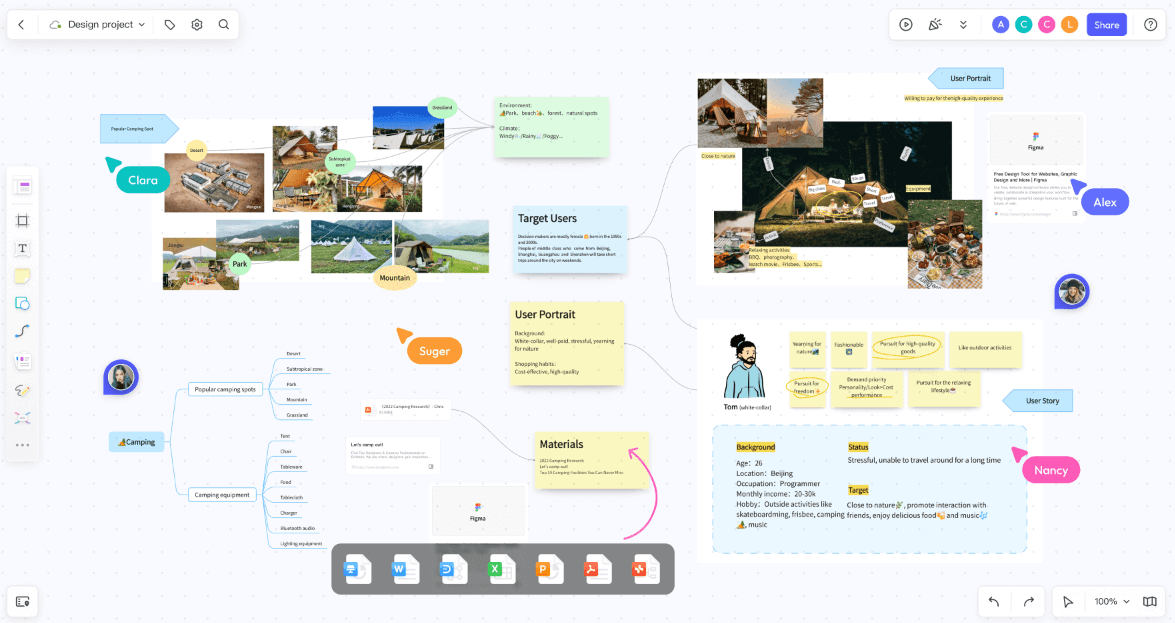
Interactive Interface: Boardmix offers an intuitive and user-friendly interface that allows teams to easily visualize their strategies, fostering a clear understanding and encouraging engagement.
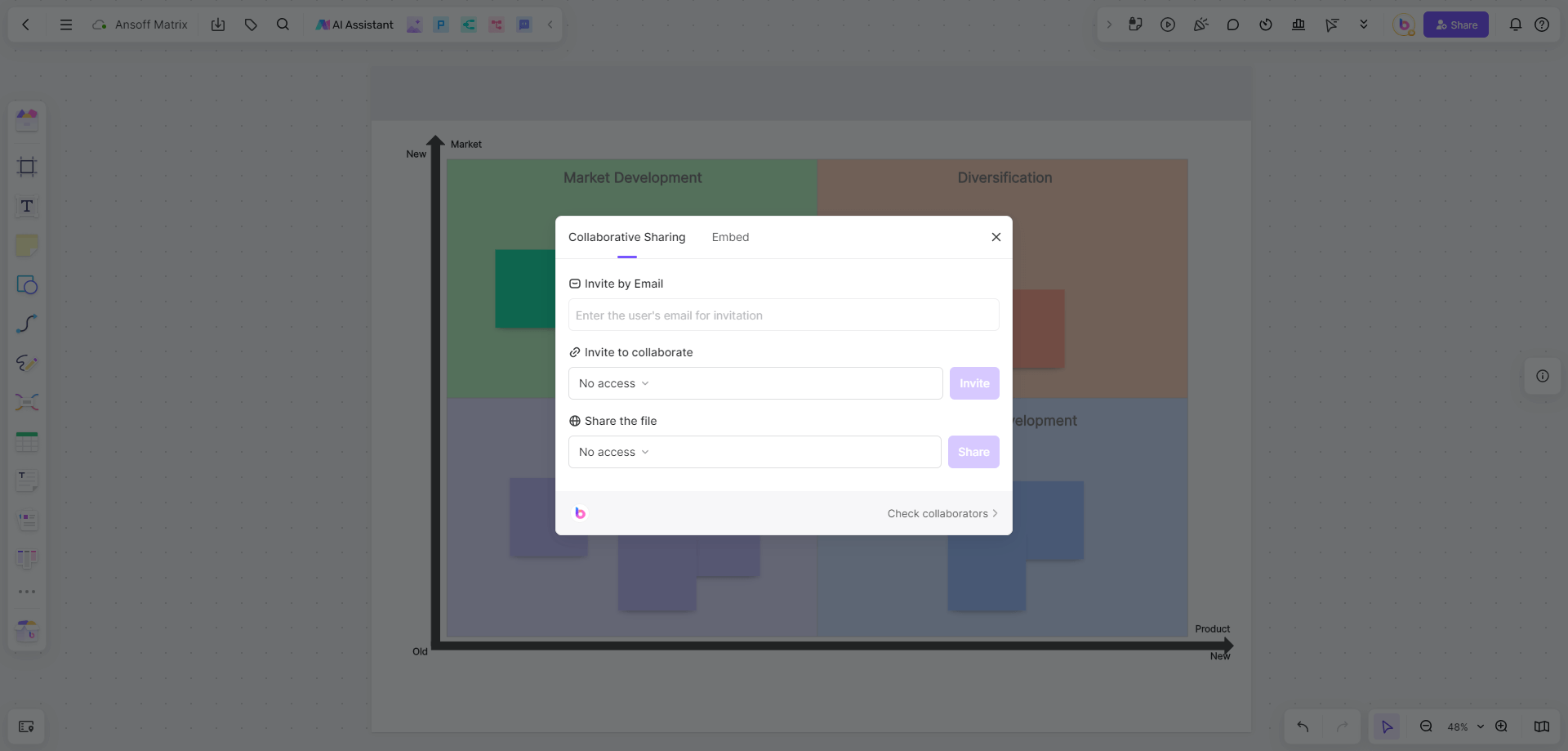
Real-Time Collaboration: Team members can work together in real-time, making it easier to brainstorm ideas, make revisions, and receive immediate feedback.
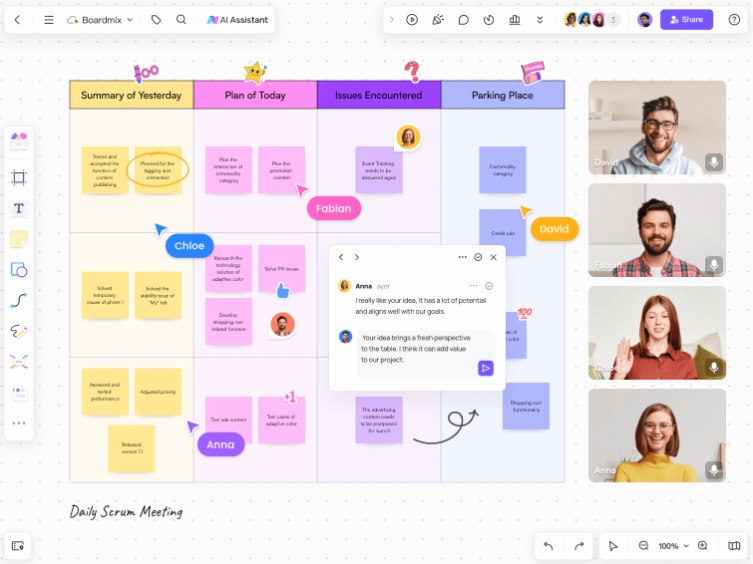
Flexible Access: Whether your team is in the office or working remotely, Boardmix is accessible anywhere at any time, providing a flexible platform for collaboration.
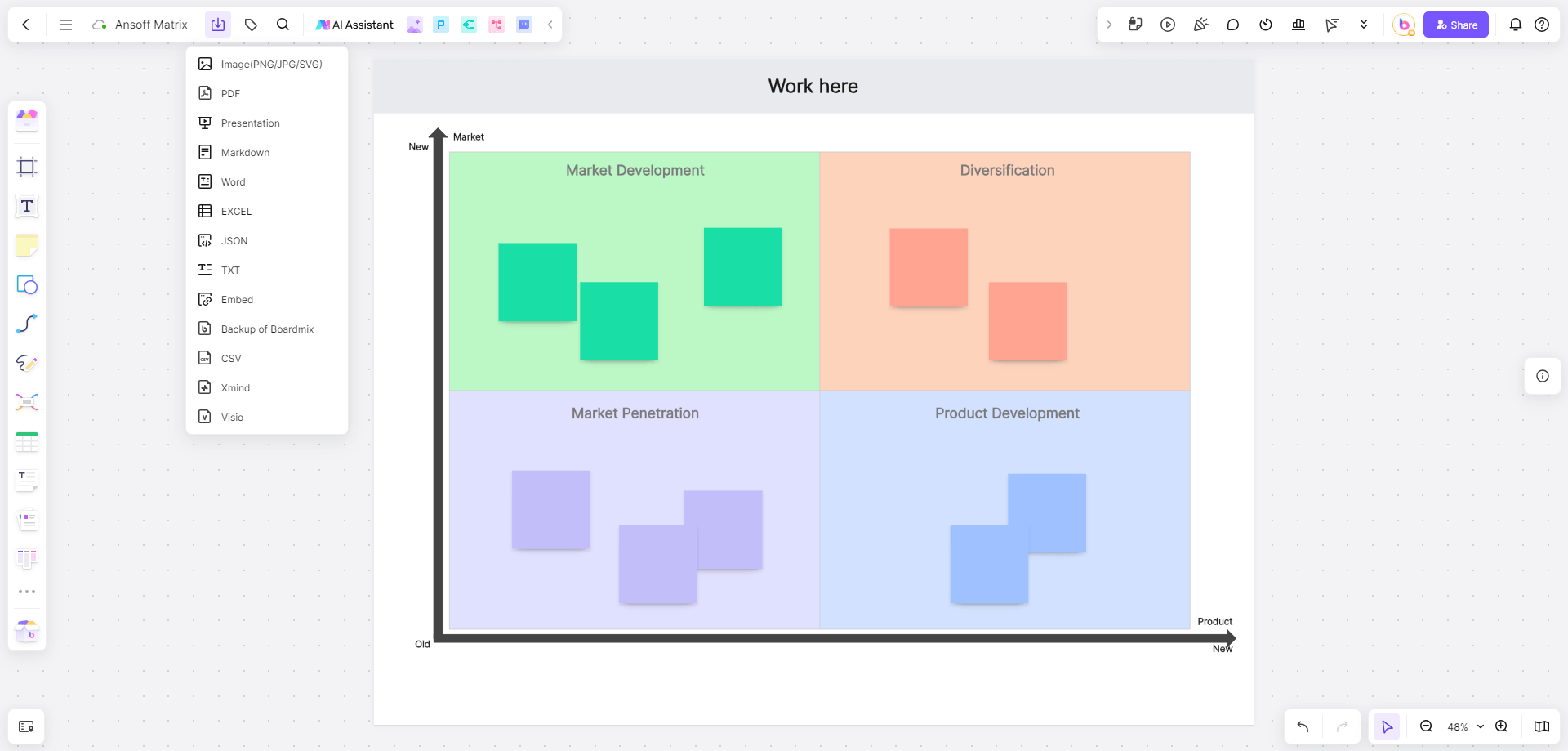
Variety of document formats: Detailed documents can be generated in different formats so that team members have a comprehensive understanding of the planning process. These documents help to track progress, identify problems and strategize future actions.
Ansoff Examples of Using Boardmix for Growth Strategy
Ansoff Example 1: Software Company's Product Development Strategy Execution
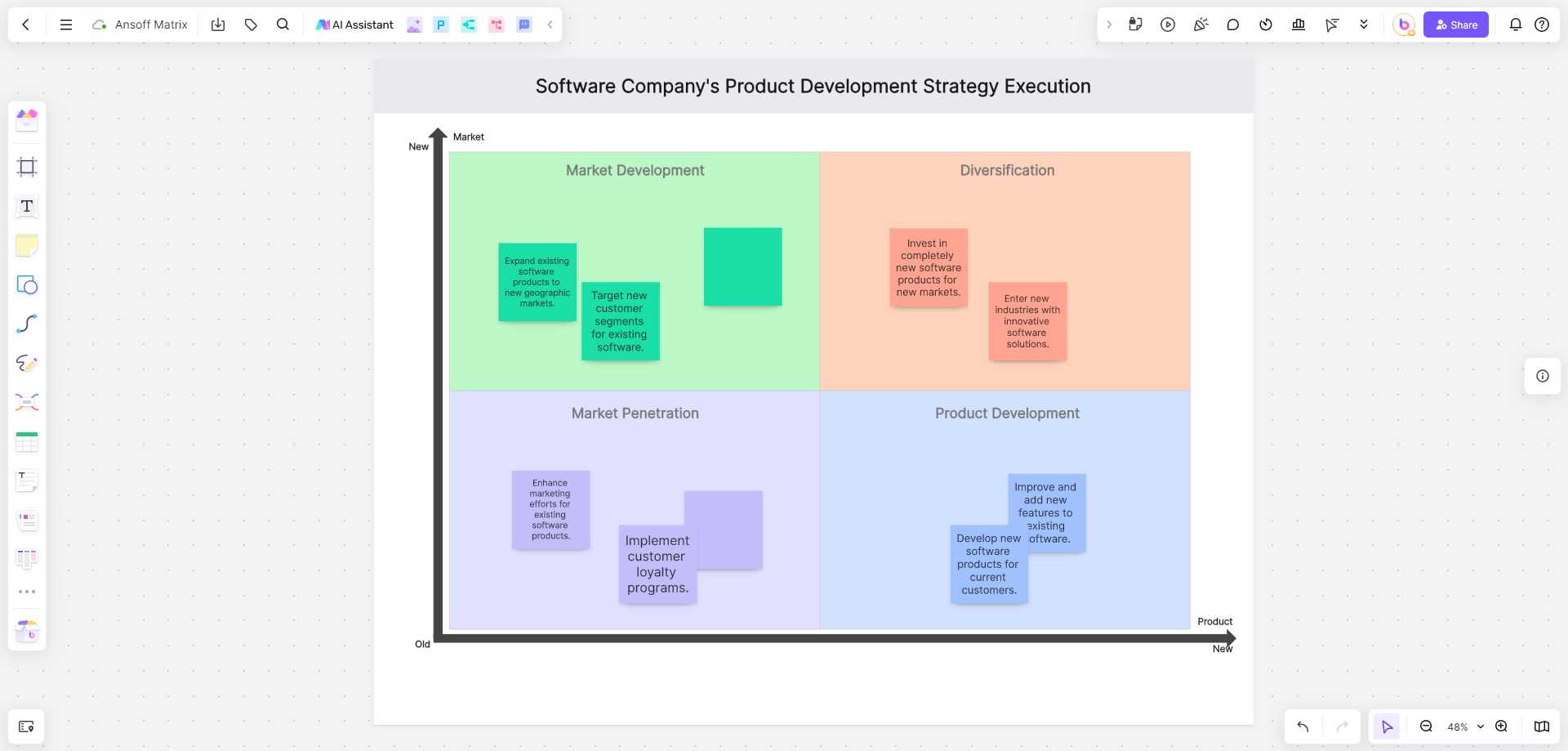
Creating the Board: The software company starts by creating a new board named "Product Development Strategy" and chooses the Ansoff Matrix from the "Add Framework" option.
Adding Strategy Elements: They then identify key elements of their strategy - like developing new software - and place them in the appropriate quadrant.
Inviting Team Members and Assigning Tasks: Once the board is set, they invite their development and marketing teams to the board and assign them respective tasks.
Collaborating in Real-Time: Throughout the process, team members use the chat feature to discuss the progress of their tasks and leave comments to provide feedback or suggestions.
Generating Reports: Once the new software development is underway, they generate task progress reports to keep track of their strategy execution.
Ansoff Example 2: Retail Business's Market Development Strategy Planning
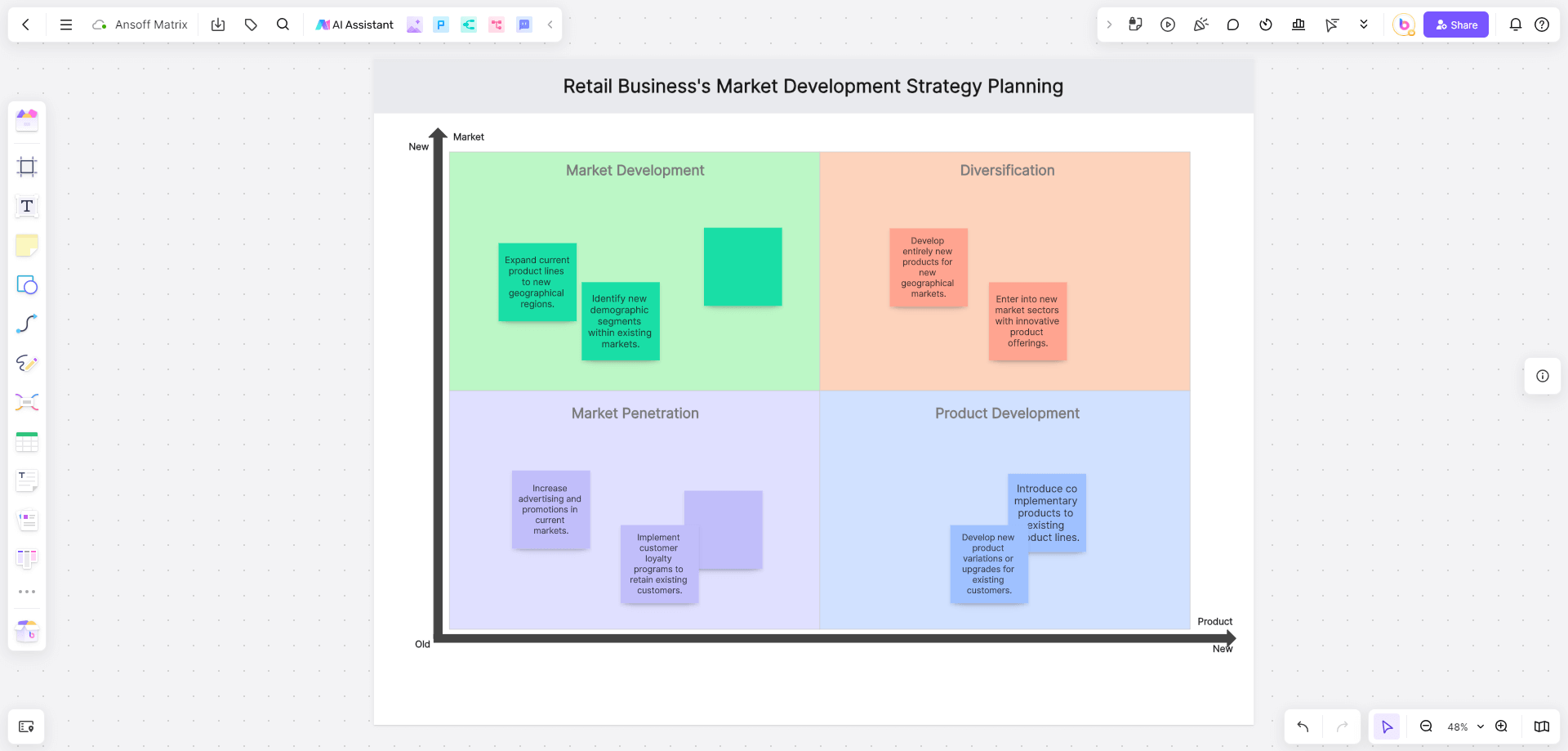
Creating the Board: The retail business creates a new board called "Market Development Strategy". They then add the Ansoff Matrix to visualize their strategy.
Adding Strategy Elements: They add their current products and the new geographical market as strategy elements on the matrix.
Inviting Team Members and Assigning Tasks: They invite their sales and distribution teams to the board, delegating tasks related to market entry strategies.
Collaborating in Real-Time: They extensively use the chat feature to communicate logistics and leave comments to share market research findings.
Generating Reports: To keep stakeholders updated, they generate board activity reports regularly and share them directly from Boardmix.
Ansoff Example 3: Food Production Company's Diversification Strategy
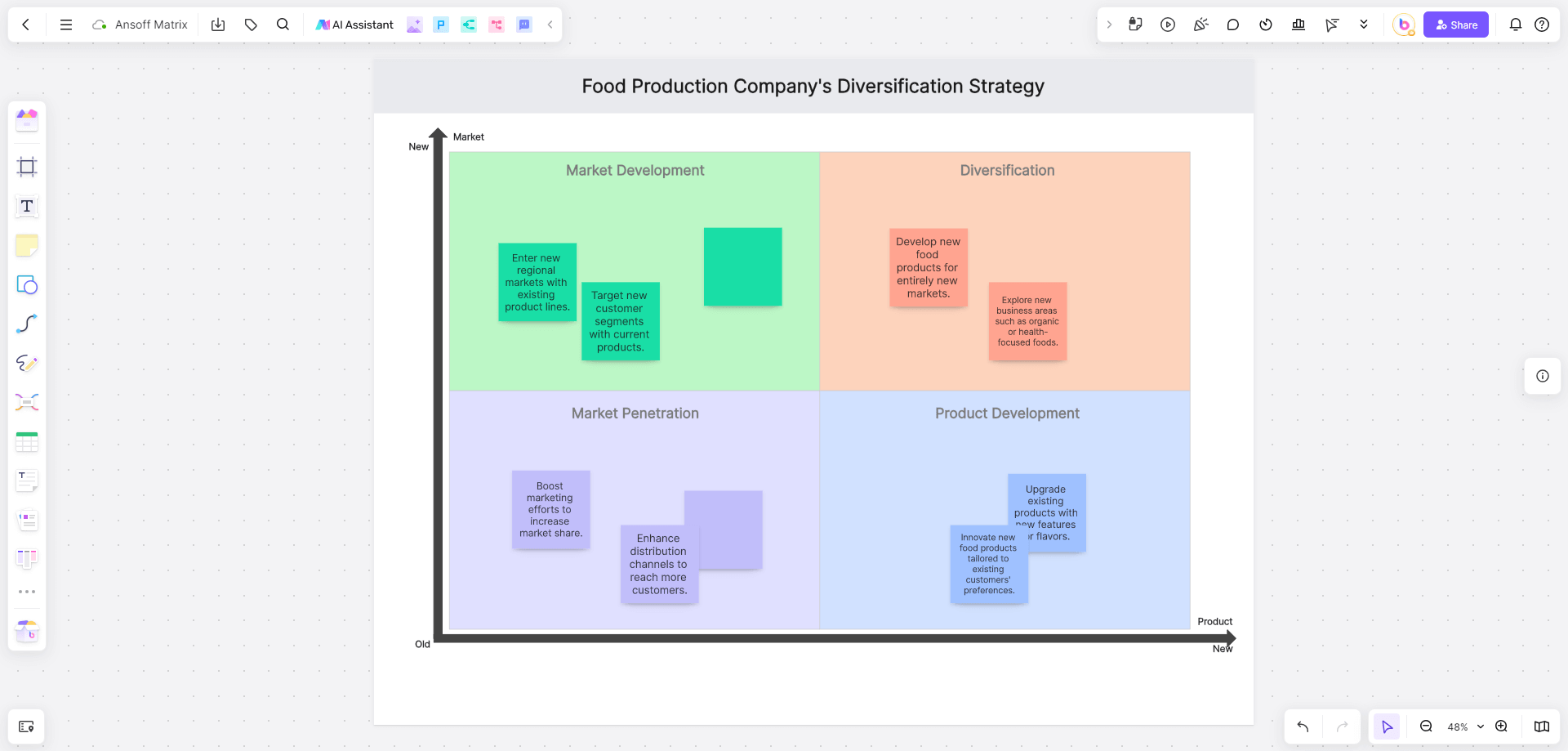
Creating the Board: The food production company sets up a new board titled "Diversification Strategy" and adds the Ansoff Matrix to it.
Adding Strategy Elements: They identify new product ideas and potential markets, adding them to the appropriate quadrants of the matrix.
Inviting Team Members and Assigning Tasks: They invite members from R&D, marketing, and sales teams to brainstorm on these new ideas and assign tasks accordingly.
Collaborating in Real-Time: Using Boardmix's real-time collaboration feature, they collectively develop a comprehensive plan for diversification.
Generating Reports: Finally, they generate task progress reports to track their diversification plan and share these reports with executives for further analysis.
Case Studies: Real-World Applications of the Ansoff Matrix
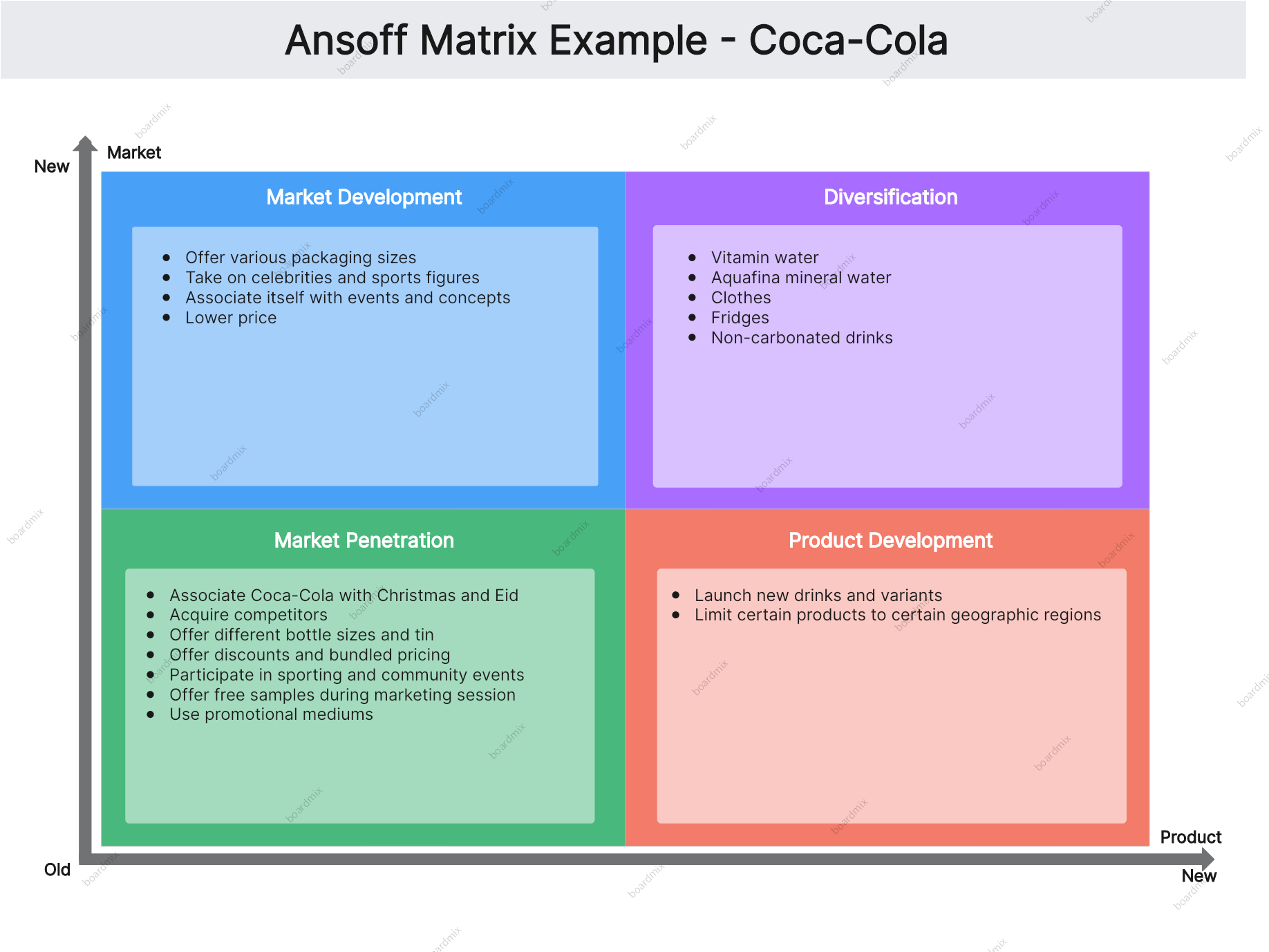
Ansoff Example of Coca-Cola: With its history spanning over a century, Coca-Cola provides an exemplary showcase of employing all four strategies of the Ansoff Matrix. For product development, they used their well-established market presence and introduced new products such as Diet Coke in 1982 to cater to health-conscious consumers, and Cherry Coke in 1985 to offer a fun twist on the classic beverage. These drinks expanded their product portfolio without leaving their familiar soft-drink market segment.
Ansoff Example of Apple: Apple leveraged the product development strategy when they announced the launch of the iPad in 2010. Despite having an array of consumer electronics such as the iPhone and MacBook, Apple identified a gap in their product line for a portable yet powerful computing device. The iPad was thus introduced to their existing customer base, meeting their computing needs while on the go and significantly bolstering Apple's market position.
Ansoff Example of Amazon: Amazon demonstrated an impressive execution of the market development strategy. Originally starting as an online bookstore in the United States in 1994, Amazon saw potential growth opportunities beyond its geographical boundaries. In 1998, it expanded its operations to Europe, starting with Germany and the UK. Over time, they extended their reach to Asia, Africa, and Oceania. Now, Amazon has dedicated retail websites for over 15 countries, delivering a vast range of products right to the customer's doorstep.
These companies' applications of the Ansoff Matrix strategies highlight its effectiveness in guiding businesses toward strategic growth. By understanding their market and products well, these industry giants made strategic decisions that spurred their growth and solidified their positions in the global marketplace.
In conclusion, mastering the Ansoff Matrix and its applications in strategic planning is a vital part of business growth. With the use of visualization tools such as Boardmix, the planning process can be more collaborative, efficient, and effective. This empowers businesses to realize their growth objectives, ensuring a successful future in their respective markets.








